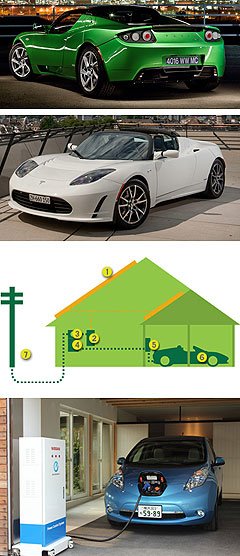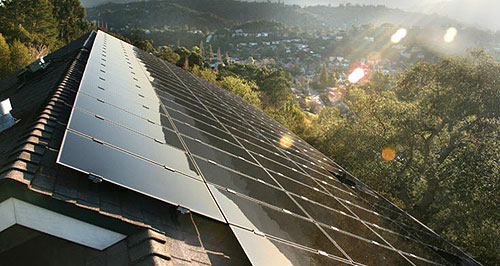News - Tesla - RoadsterTesla offers replacement battery pre-purchase dealShocking: Tesla’s battery packs can enjoy a retirement storing solar energy for households. Used Tesla battery packs to store solar energy in pioneering replacement offer19 Aug 2011 PRE-PURCHASING an EV battery for when the original meets the end of its design life and then using the old battery to store solar energy for domestic use is one of the radical plans dreamed up by Silicon Valley-based electric car company Tesla. Tesla Motors Australia national sales and marketing manager Jay McCormack told GoAuto of the scheme, into which Australian customers can enter by paying a $12,000 (including taxes) premium on top of the purchase price of their vehicle. Tesla claims its lithium-ion batteries are landfill safe but regards throwing the spent batteries out as a waste of money, firstly because the materials can sold to recycling companies and secondly because after its seven-year/160,000km design life, the battery still retains about 70 per cent of its charge capacity. Mr McCormack described a scheme whereby Telsa customers can pre-purchase replacement batteries, which because of the technology’s rate of development are likely to be lighter than the originals while offering greater range by the time they are needed, increasing the performance of the vehicle while simultaneously extending its life. “70 per cent (remaining charge capacity) would be a minimum,” said Mr McCormack. “Depending on how you care for your battery and the way you charge your battery that could of course be extended.”  Left: Tesla Roadster. Below: A Nissan Leaf powering a Japanese house. Left: Tesla Roadster. Below: A Nissan Leaf powering a Japanese house.Customers who opt to keep using their car’s original battery pack longer than seven years are refunded $1000 for every year they continue to do so, a good deal considering the original battery pack fitted to the $220,000+ Roadster accounts for about half its build cost and that the deal is transferable, something Mr McCormack believes will increase the car’s resale value. If the customer chooses to swap, they get to keep the original battery pack, which can then be connected, for example, to their home solar energy system to store power generated during daylight hours. Mr McCormack said even at 70 per cent capacity, the Roadster’s battery pack can still retain enough charge to power an average household for about two days, useful if there is a mains power outage or in cloudy weather when solar energy generation is reduced. This also allows for night-time energy consumption to be drawn from stored solar energy, reducing or eliminating the household’s reliance on fossil- or nuclear-generated energy. The stored energy can also be used to top up an EV’s battery overnight. Both Toyota and Nissan have mooted similar systems in recent weeks, the former inspired by stories of customers in Japan using the in-built AC power outlet of their hybrid Estima people mover (named Tarago in Australia) to power their household appliances following disruption to the electricity grid following the March 11 earthquake and tsunami. Toyota has demonstrated a Prius powering various household appliances and says from next year it will offer an optional AC outlet on its hybrid hatch range – although being a hybrid with relatively small battery capacity, it will work more like a generator if required to provide power for long periods of time, meaning it must be operated outdoors, or at least in a well-ventilated area. Nissan has suggested the battery of its Leaf EV can be used as a household electricity storage device and has demonstrated the system at a house built in front of Nissan’s Japanese headquarters. The company hopes to roll out the system – which requires no modifications to the Leaf itself – by the first quarter of next year. The Leaf’s 24kWh lithium-ion battery is said to hold enough charge to power an average Japanese home for about two days. Tesla’s chairman and major investor Elon Musk, who made his fortune co-founding online payment system PayPal, also invests in and chairs Californian solar energy company SolarCity. SolarCity has installed more than 2500 solar home charging stations for EVs in the US and offers Tesla customers a deal similar to that announced by Ford last week for US Focus Electric buyers, in which the Blue Oval has teamed up with a solar energy provider to install solar panels on the customer’s roof claimed to be capable of generating enough electricity to drive approximately 1600 kilometres per month for $US10,000. In partnership with Rabobank, SolarCity is also creating a solar-powered fast-charge network enabling EVs to travel the 680km between San Francisco and Los Angeles using Highway 101. Although SolarCity does not have a presence in Australia, Mr McCormack said Tesla customers with solar panels should have no problem using them to charge their EV. He added that in seven years’ time when the Roadster’s battery packs come up for replacement, it will be relatively straightforward for Australian customers to replicate the Tesla/SolarCity solution of charging used Roadster batteries with solar energy to use in the household. “It would just be a marriage between your energy storage system and a solar provider to mirror or mimic what SolarCity offers to customers,” he said. “Obviously it’s going to be a little bit of time down the track before the battery units start coming out of Roadsters, a minimum of seven years. “The real reason a lot of people in Australia aren’t off-grid is the lack of a facility to capture a large amount of energy at the moment, hence pumping it straight back into the grid.”  Read more |
Click to shareTesla articlesResearch Tesla Motor industry news |
















Facebook Twitter Instagram